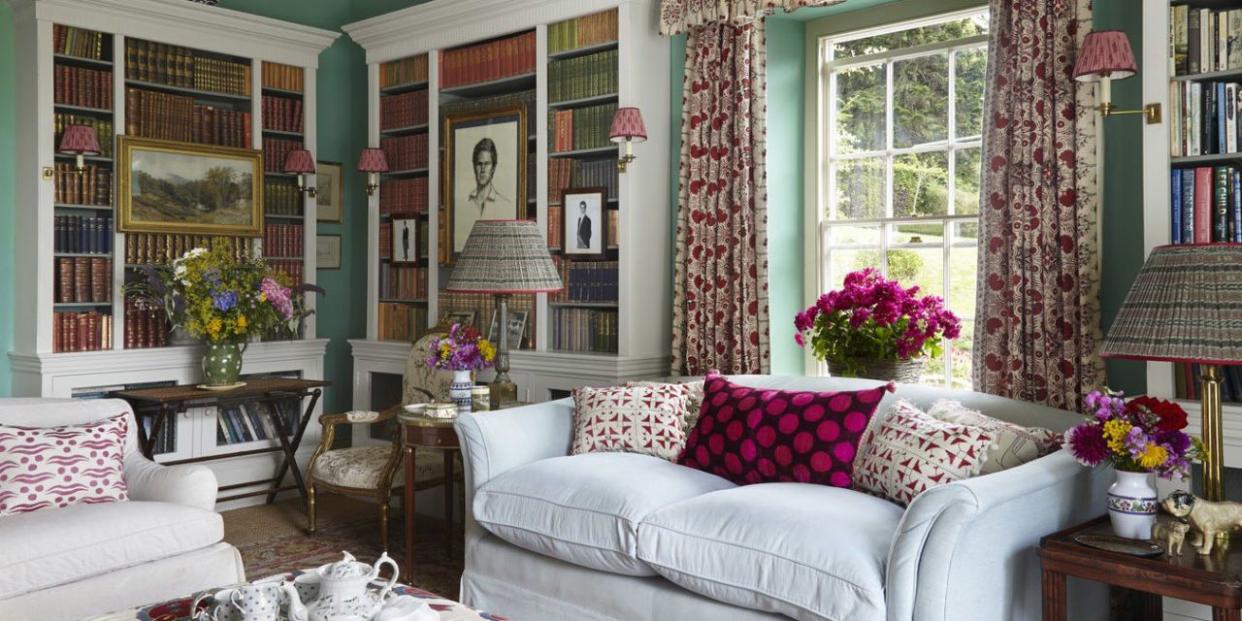How Interior Designer Penny Morrison Turned an Unlivable Home Into a Colorful Masterpiece

"I eat, sleep, and dream fabrics and surroundings," says interior designer Penny Morrison. She is sitting on a blue-striped linen chair, her arm resting on a blue, green, and red leaf-print cush- ion, with a view of the lushly verdant countryside and undulating hills stretching out in the distance behind her. "I get such pleasure from being in a pretty environment."
Morrison's environment could hardly be prettier. Her 1790 house in Wales is just half a mile beyond the English border, and it's a spectacular showcase of color, pattern, and texture in a setting of almost absurdly bucolic beauty. Bordered by rolling lawns, a stream, a walled garden, and—further on—a forest in which her husband, art dealer Guy Morrison, walks their two dogs every day, the house looks from the outside like a solidly British country home. But the interior immediately reveals Morrison's far-from-conservative tastes, and her strong belief in comfort as a first principle of design.
"I think a house should be a home," she says firmly. "You should always be able to put your feet up on the sofa. The way a house is done dictates how people will feel in it."
The Morrisons stumbled upon the house by accident 26 years ago, while paying a weekend visit to friends nearby. Hardly altered since it was first built, it had been inhabited by only two families. Although almost everything needed attention, the couple fell in love with the building and its setting. "We hadn't been planning to move and didn't even really know what we would do with the place," Morrison says. "But I had always wanted something like a Scottish lodge, a house in which every ground-floor room opens onto the garden, so in summer it can be entirely open. And this had the advantage of being not as far away as Scotland!"
Morrison attributes her love for wide-open spaces and an indoor- outdoor lifestyle to her upbringing in South Africa. She grew up in Johannesburg but left the country after divorcing her first husband. Moving to London with her young daughter, she began working in property development and then decorating show apartments as a sideline. "I've never had any formal training, but I've always been interested in the way things look," she says. "It was after I redid this house that people began to ask me to start decorating for them, and it just grew from there."
The house was, Morrison says, "unlivable" when they bought it— riddled with dry rot, in need of a new roof and new windows, plumb- ing, and wiring. "It wasn't even a matter of making it attractive," she says, "just habitable." Nonetheless, she was thrilled to find a historic property that was unspoiled by renovation. The rooms were large and beautifully proportioned, the views glorious. Aside from transforming several bedrooms into new bathrooms and raising the ceiling over the central staircase by five feet, the Morrisons retained the essential structure of the house.
"What really makes these rooms is the scale," Morrison says, gesturing at the spacious drawing room. "I believe in having large pieces of furniture, big pictures, and hanging them alongside lots of others to really amplify the space. If you have a collection, like these blue-and-white vases, and you group them well, it keeps the eye focused without feeling cluttered."
[embed_gallery gid=2467 type="simple"]
Most of the furniture was bought after they moved in, often at country-house sales, and Morrison, who admits to being an invet- erate collector of china, gradually filled the rooms and hallways with an often-quirky mix of artifacts alongside her husband's art collection. (The walls of the central staircase are lined with stuffed animals in glass boxes and with deer heads and antlers, some from shoots on the estate organized by Guy.)
As Morrison developed her own fabric and wallpaper line, she slowly began to put in new curtains and reupholster the soft, squashy armchairs and sofas and large ottomans that she likes. The library, in particular, is a testament to her textile passions; it's filled with the wonderfully contrasting patterns and vivid hues of cush- ions, kilims, and materials that come from a new fabric and home accessories line, Irving and Morrison, which she started two years ago with designer Carolina Irving.
These fabrics, sourced in India, Morocco, Turkey, and other exotic locales, sit alongside equestrian paintings, leather-bound books, and a portrait of the Morrisons' son, Ted. "I don't like a matchy look," she says. "I think people should have things from all periods in a room. Otherwise it looks like you've been to a department store."
The garden, too, has developed over the years, as the Morrisons put in the balls of box and sculptural hedges that give it distinctive form and redid the walled garden to create an outdoor living area in sum- mer. "One of the joys of living here are those wonderful late-summer nights," Morrison says. "We eat lunch and dinner outside whenever possible, even if it means holding an umbrella over our heads!"
[embed_gallery gid=2467 type="simple"]
You Might Also Like

